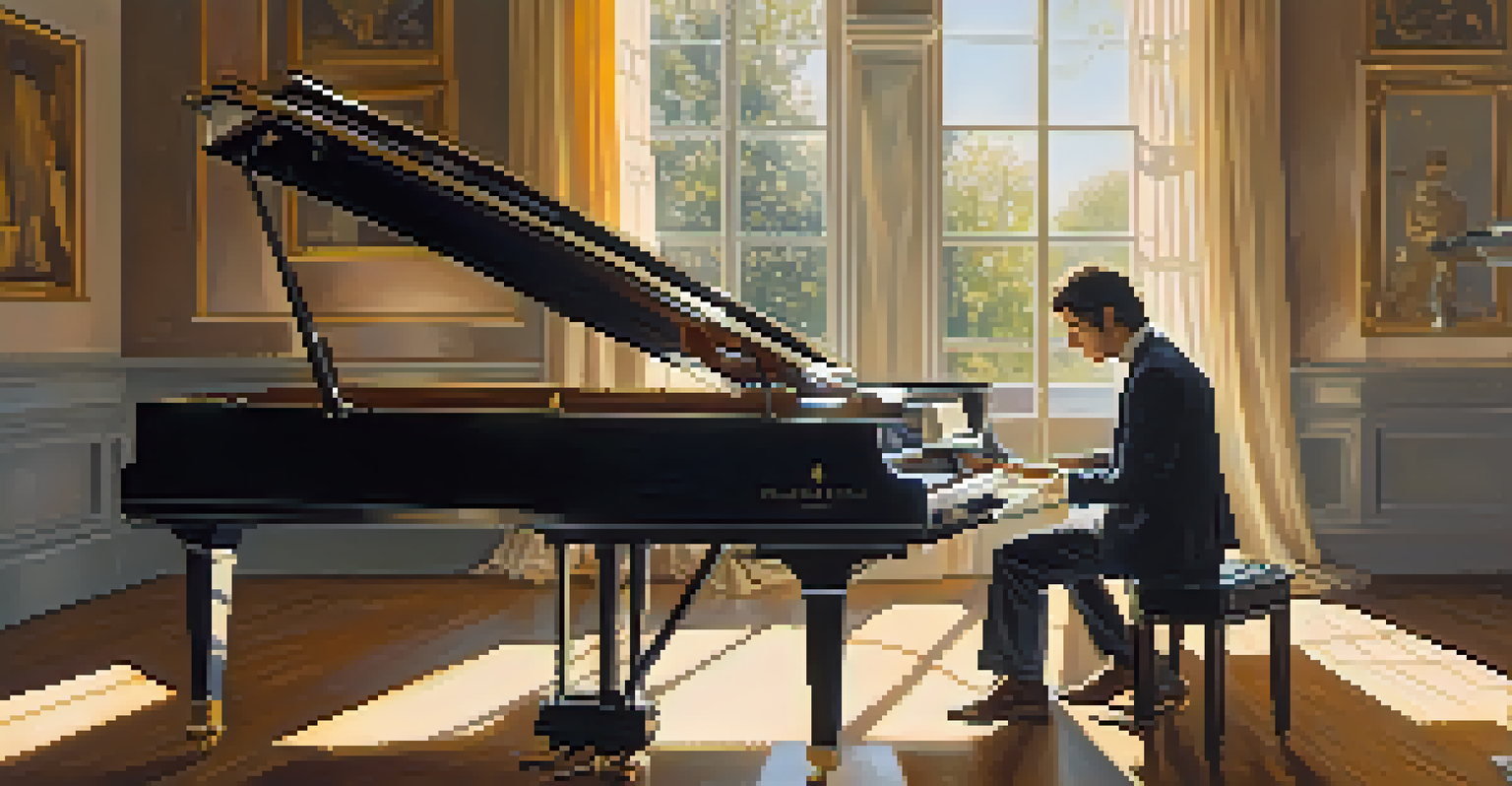Symbols and Sounds: Nonverbal Communication in Music Notation

The Basics of Music Notation: Symbols as Language
Music notation serves as a language of symbols, translating sound into visual form. Just as words convey meaning, musical notes and symbols allow musicians to communicate ideas and emotions. Understanding these symbols is essential for reading and interpreting music, making it an integral part of a musician's education.
Music is the shorthand of emotion.
For example, a quarter note indicates a specific duration of sound, while a sharp sign alters the pitch. Each symbol carries its own significance, much like letters in a sentence. This visual representation enables musicians to share complex compositions without needing to verbalize every detail.
Moreover, the use of symbols fosters collaboration among musicians. When playing together, they can instantly recognize and interpret the same notations, ensuring a cohesive performance. This shared understanding is the essence of nonverbal communication in music.
Rhythm and Timing: The Heartbeat of Music
Rhythm is the backbone of any musical piece, creating structure and movement. In music notation, rhythms are depicted through various note shapes and rests, which dictate how long a sound is held or silence is observed. This nonverbal communication is crucial for maintaining tempo and flow in a performance.

Consider how a conductor uses a baton to guide an orchestra; their movements reflect the rhythm, allowing musicians to interpret the timing without words. Through notation, the same concept is applied, enabling musicians to visually grasp the intended rhythm even before they play.
Music Notation as a Language
Music notation translates sound into visual symbols, enabling musicians to communicate ideas and emotions effectively.
Ultimately, rhythm serves as a universal language in music. Regardless of the genre or culture, the patterns of beats resonate with listeners, making rhythm a powerful tool for emotional expression.
Dynamics and Expression: Conveying Emotion Nonverbally
Dynamics in music notation indicate the volume at which a piece should be played, ranging from soft whispers to powerful crescendos. Symbols like 'p' for piano (soft) and 'f' for forte (loud) guide musicians in expressing the emotional depth of a piece without saying a word. This allows for a nuanced performance that can evoke a wide range of feelings.
Without music, life would be a mistake.
For instance, a sudden shift from loud to soft can create tension or surprise, drawing the listener deeper into the musical narrative. Musicians rely on these dynamic markings to interpret the composer’s intentions, making them essential for a compelling performance.
Moreover, dynamics are not just about volume; they also influence the overall energy of a piece. Just like a painter uses colors to convey emotion, musicians use dynamics to evoke feelings, proving that music is a profound form of nonverbal communication.
Articulation: The Nuances of Sound
Articulation refers to how individual notes are played, and it significantly impacts the character of the music. Notation includes symbols like staccato (short and detached) and legato (smooth and connected), guiding musicians in how to express each note. This attention to detail enhances the overall musical interpretation, making it more engaging.
Think of articulation as the difference between a sharp, energetic dance and a slow, flowing waltz. Each style requires specific articulations that can dramatically change the piece's mood. Musicians must understand these nuances to effectively convey the intended emotions.
Rhythm: The Heartbeat of Music
Rhythm serves as the backbone of music, guiding tempo and flow through various note shapes and rests.
In essence, articulation serves as the fine brushstrokes in a musical painting. By mastering these techniques, musicians can communicate not just notes, but the very essence of the music they are performing.
Harmony and Chords: Layering Nonverbal Communication
Harmony is the combination of different musical notes played simultaneously, creating depth and richness in sound. In notation, chords are represented through stacked notes, allowing musicians to grasp the harmonic structure at a glance. This layering of sounds adds complexity to music, enhancing its emotional impact.
When musicians understand the harmonic framework, they can respond to one another more intuitively during a performance. For example, a guitarist strumming a chord provides a foundation for a singer's melody, illustrating how harmony acts as a collaborative force.
Ultimately, harmony encapsulates the idea of unity in diversity. Just as diverse voices contribute to a choir, varied chords enrich the musical landscape, proving that nonverbal communication in music is a collective endeavor.
The Role of Silence: The Unspoken Notes
Silence in music is just as powerful as sound, often referred to as a 'rest.' In notation, rests indicate pauses or breaks in the music, allowing for reflection and anticipation. This nonverbal cue creates tension and can dramatically alter the listener's experience, highlighting the importance of what is left unsaid.
Consider how a dramatic pause in a speech can amplify its emotional weight; the same principle applies to music. A well-placed rest can evoke feelings of longing or suspense, drawing the audience deeper into the narrative.
Silence: The Power of Rest
Silence in music, represented by rests, is a crucial element that enhances emotional expression and storytelling.
Thus, silence serves as a crucial component of musical expression. By mastering the art of silence, musicians can enhance their storytelling and engage listeners in a profound way.
Cultural Variations in Music Notation
Music notation is not universal; it varies significantly across cultures and genres. Different traditions have developed unique systems of notation that reflect their musical styles and values. For example, Western music typically uses a staff system, while Indian classical music employs a system called 'sargam,' which uses syllables to represent notes.
These cultural variations influence how musicians communicate and interpret music. Understanding these differences is essential for musicians who wish to collaborate across genres or cultural boundaries, as it enriches their musical vocabulary.

Ultimately, embracing these diverse notational systems fosters a deeper appreciation for global music. It reminds us that while the symbols may differ, the emotions conveyed through music are universally understood, reinforcing the power of nonverbal communication.